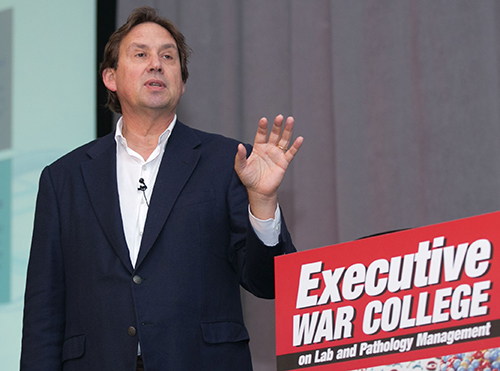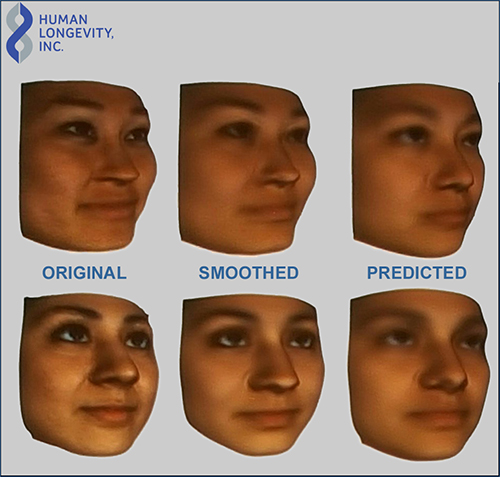At Human Longevity, Inc. and the United Kingdom’s 100,000 Genome Project, knowledge gained from whole-genome sequencing is starting to be used to improve patient care
NEW ORLEANS, LA—Whole-human gene sequencing is poised to provide significant contributions to improving clinical care. That was one conclusion from expert speakers at the 21st annual Executive War College on Medical Laboratory and Pathology Management that happened here this week.
How fast knowledge from whole-human gene sequencing finds its way into clinical diagnostics and healthcare can be debated. But what is unquestioned, based on these presentations, is that insights gained from the analysis of large numbers of human genomes will trigger a revolution in how pathologists and physicians diagnose, treat, and care for patients.
Brad Perkins, MD, CMO, Human Longevity, Inc.
The first keynote presentation on large-scale whole-human genome sequencing was delivered by Brad Perkins, MD, Chief Medical Officer, at Human Longevity, Inc. (HLI) of San Diego, California. It is important to understand two facts about HLI. First, it was founded by J. Craig Venter, PhD, and two other innovators specifically to research the whole-human genome for the purposes of understanding how to foster wellness and extend the health lifespan of humans.
Second, HLI would do this by sequencing tens of thousands of whole-human genomes. In fact, according to Perkins, HLI has already sequenced 25,000 whole-human genomes. It now has the world’s largest database of human genomes. Its goal is to be sequencing 100,000 genomes per year by the end of 2016 and to have one million genomes sequenced by 2020.

During his keynote presentation, Brad Perkins, MD (above), Chief Medical Officer, at Human Longevity, Inc. (HLI) of San Diego, gave pathologists and medical laboratory executives attending this month’s Executive War College an overview of HLI’s genome-sequencing program and its goal to achieve a “healthy, high-performance lifespan and change the face of aging,” as well as using the knowledge derived from these genomes to improve medical practice. (Photo by Linda Reineke; copyright: The Dark Report.)
Perkins explained the strategy for mining this data to identify ways to understand how an individual’s genes affect his or her health. Three examples illustrate the remarkable advances that are happening at HLI.
“From our study of telomeres, we are developing the ability to use this data to accurately estimate the age of the individual,” noted Perkins. “We are also learning how to use this same telomere information to predict the remaining life expectancy for the individual.”
A second area of research is to correlate an individual’s genotype and phenotype. “Take the example of a patient who presents with a medical history of ammonia odor, renal insufficiency, and GI discomfort,” he stated. “We can now associate a gene mutation for this condition, which is only activated if that person has a specific strain of E. coli. Therapeutic options can include dietary restriction, antibiotics, and more informed management of the patient.”
The third example which captured the full attention of the Executive War College audience is that, after the analysis of the first 10,000 whole-human genomes, HLI now has an intriguing capability. “Use of ‘machine learning’ to assess this data now allows us to predict the height, weight, and color of a person’s eyes,” explained Perkins. He then revealed to the audience another unimagined opportunity. “Using the genome, we are able to create an image of that individual’s face,” he added.
Perkins then showed a graphic representation of the how one HLI researcher’s face would look. He then put up an actual photo of that researcher’s face. It was an extremely close match!

The example above demonstrates how HLI’s prediction technology is able to quite accurately “predict” the bodily characteristics of individuals based on their genomes. (Image copyright: Human Longevity Inc.)
Sue Hill, OBE, PhD, CSO, National Health Service (England)
The second keynote speaker on large-scale, whole-human genome sequencing was Sue Hill, OBE, PhD, Chief Scientific Officer for England’s National Health Service (NHS), based in London. In recent years, the NHS has launched the 100,000 Genomes Project.
During her presentation, Hill noted that this program has already sequenced 8,000 whole-human genomes. There is also an important difference in the goal of the UK program compared to the sequencing effort at Human Longevity, Inc. The 100,000 Genome Project is focused on rare inherited diseases and common cancers and how to move that knowledge to physicians so they can improve the care they provide to patients.
100,000 Genome Project
For this reason, the 100,000 Genome Project is demonstrating one road map that hospitals, health systems, and others in the United States can follow as they collect human genome data and introduce the resulting knowledge into clinical care. Essentially, this is one of the earliest and biggest efforts in the world to gather the data and move it rapidly into clinical care settings.
“The whole-human genomes being sequenced come from patients who are drawn from routine care and treated through routine channels,” noted Hill. “Each participant provides a fully informed consent providing for a wide range of data and tissue capture and broad categories of use including research and industry. However, neither data nor tissues [go] outside NHS-controlled ‘safe havens’ and all users [are] properly authorized and monitored.”
The types of specimens collected for gene sequencing include:
• fresh frozen tissue; and
• blood.
Researchers are currently focusing on these cancers: breast, prostate, colorectal, ovarian, lung, and CLL. Study is commencing on renal cancers and sarcomas.
“One early focus of the program is to gather knowledge that can support the latest wave of drugs coming to market,” stated Hill. “Advancing personalized medicine and supporting theranostics is timely because of advances in this field. For example, 28% of the drugs approved by the FDA during 2015 had a companion diagnostic test and, of all those drugs, more than a third were cancer drugs.”

During her keynote address at this year’s Executive War College in New Orleans, Sue Hill, OBE, PhD, CSO, National Health Service (England), discussed her country’s whole-human genome sequencing program and important differences between the UK’s goals and those of Human Longevity, Inc. (Photo by Linda Reineke; copyright: The Dark Report.)
One early example of how knowledge from the 100,000 Genome Project is changed clinical care in the United Kingdom involves the 60,000 users of Warfarin in this nation. “There is massive variability in individual response to this drug,” observed Hill. “There can be a variability of up to 40 times in a dose and this variability is a major cause of adverse reactions. Dosing is typically determined on a ‘trial and error’ approach in the INR clinics.”
“Genetics have already been identified that account for significant element of variation in response to warfarin,” she continued. “Research has established genotype-guiding protocols that allow clinicians to get to the right dose sooner and with fewer adverse effects. This improves both patient outcomes and patient experience.”
EWC Highlights How Medical Laboratories Can Deliver Superior Testing Services
Because there is now a regular flow of new clinical protocols moving from the research findings for the 100,000 Genomes Project, pathologists and clinical laboratory professionals may want to track these developments by visiting the project website (at the URL: http://www.genomicsengland.co.uk).
The examples provided are just a few highlights from the detailed and far-ranging information presented by experts at the many sessions dealing with molecular diagnostics, genetic testing, and how medical laboratories are delivering more value with the lab testing services they provide to hospitals, physicians, patients, and payers.
Overall, over 60 sessions and 100 speakers shared insights and information at this year’s Executive War College. More than 850 attendees from seven countries were in attendance. Readers of Dark Daily can view the full agenda at the URL: http://www.executivewarcollege.com/agenda.
—Michael McBride
Related Information:
Dark Intelligence Group Upcoming Seminars and Meetings for Laboratory Professionals
Scott Skellenger, Health IT and Informatics, Human Longevity Inc. Twitter Feed



